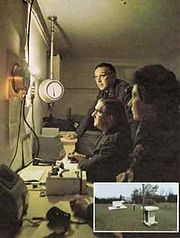
Bomb Power Indicator
Encyclopedia

United Kingdom
The United Kingdom of Great Britain and Northern IrelandIn the United Kingdom and Dependencies, other languages have been officially recognised as legitimate autochthonous languages under the European Charter for Regional or Minority Languages...
Royal Observer Corps
Royal Observer Corps
The Royal Observer Corps was a civil defence organisation operating in the United Kingdom between 29 October 1925 and 31 December 1995, when the Corps' civilian volunteers were stood down....
controls and nearly 1,000 ROC underground monitoring posts, across the United Kingdom, during the Cold War
Cold War
The Cold War was the continuing state from roughly 1946 to 1991 of political conflict, military tension, proxy wars, and economic competition between the Communist World—primarily the Soviet Union and its satellite states and allies—and the powers of the Western world, primarily the United States...
that would have detected any nuclear explosions and measured the peak-overpressure of the blast waves.
Overview
The instruments, operated by volunteers, measured the level of peak-overpressure at the instrument's location. Once readings had been combined with information provided by the Ground Zero IndicatorGround Zero Indicator
The Ground Zero Indicator, known by the acronym GZI was a specially designed shadowgraph instrument used by the British Royal Observer Corps during the Cold War to locate the Ground Zero of any nuclear explosion.-Overview:...
s it would be possible to estimate the size of the nuclear explosion in megatons. Detailed BPI information was backed up by the automatic AWDREY readings.
The BPI was designed and built by the Atomic Weapons Establishment
Atomic Weapons Establishment
The Atomic Weapons Establishment is responsible for the design, manufacture and support of warheads for the United Kingdom's nuclear deterrent. AWE plc is responsible for the day-to-day operations of AWE...
at Aldermaston
Aldermaston
Aldermaston is a rural village, civil parish and electoral ward in Berkshire, South-East England. In the 2001 United Kingdom Census, the parish had a population of 927. The village is on the southern edge of the River Kennet flood plain, near the Hampshire county boundary...
and tested for performance and accuracy on real nuclear explosions at the 1957 Kiritimati (or Christmas Island)
Kiritimati
Kiritimati or Christmas Island is a Pacific Ocean raised coral atoll in the northern Line Islands, and part of the Republic of Kiribati....
nuclear bomb test (after being mounted onboard a ship). A number of BPIs were also tested in Australia during the Operation Buffalo series of nuclear tests
British nuclear tests at Maralinga
British nuclear tests at Maralinga occurred between 1955 and 1963 at the Maralinga site, part of the Woomera Prohibited Area, in South Australia. A total of seven major nuclear tests were performed, with approximate yields ranging from 1 to 27 kilotons of TNT equivalent...
mounted at various distances from ground zero
Ground zero
The term ground zero describes the point on the Earth's surface closest to a detonation...
.
Operations
Above ground a pair of circular plated baffles would be affected by the passing of the blast wave. The detector was connected by a steel pipe to the indicator dial below ground in the protected monitoring post. The dial was wall mounted and measured readings from 0.1 to 5 pounds per square inch peak overpressure. Readings below 0.3 pounds per square inch were noted but not reported.The baffles were normally stored below ground and only screwed onto the top of the pipe at the start of exercises or at Transition To War
Transition To War
Transition to war is a North Atlantic Treaty Organization military term referring to a period of international tension during which government and society move to an open war footing...
. Outside of operations the BPI pipe was protected by a screw on cap and there was a drain valve at the base of the instrument to remove any excess rainwater.
If the BPI registered a reading of 0.3 or higher the operator would wait ten seconds before pressing the reset button and making a report to the group control. One minute after a BPI reading an observer is sent above ground to change the photographic papers in the Ground Zero Indicator
Ground Zero Indicator
The Ground Zero Indicator, known by the acronym GZI was a specially designed shadowgraph instrument used by the British Royal Observer Corps during the Cold War to locate the Ground Zero of any nuclear explosion.-Overview:...
.

